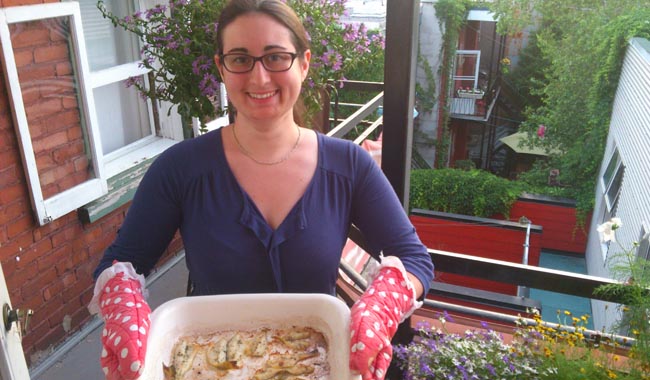Cookbooks a recipe for colonialism

By Marci Becking
MONTREAL – Marie-Anne Gagnon says Canadian cookbooks have been a tool for colonization.
“Very few recipes actually have an Aboriginal reference in their title, and those that do have questionable links to actual Aboriginal people,” says Gagnon who, in pursuing her Master of Arts degree in Public History at Carleton University, discovered that the story of Canada as presented in 1960s cookbooks, is a very linear “settler” narrative. “At least, I have not been able to find their exact origin (for example Indian Pudding, which is made with cornmeal, sugar, and spices, and served with Hard Sauce).”
“Most mentions of ‘Indians’ are found in short historical explanations found at the beginning of a book, chapter, or recipe,” she says. “These recognize the contribution of Aboriginal people to Canada’s culinary culture, usually by noting how Indians ‘taught’ pioneers how to use pumpkin, maple syrup, or corn. Mentions of Aboriginal people are referred to in the past tense rather than the present, emphasizing their historical (long-past) role in cultural exchange, rarely their modern one.”
Gagnon says that in her research, Aboriginal people are very rarely identified as being nation-specific. For example, the cookbooks almost never recognize Aboriginal cultural diversity.
“1960s cookbooks really seem to present an ‘imaginary Indian’, or ‘imaginary Indians’ who stand in for all Aboriginal people. Canadian cookbooks from the late 60s were trying to define a national cuisine for the Centennial. Not an easy task, considering the country’s cultural diversity, both in terms of Aboriginal people and immigrants. Officials were slowly moving towards a ‘cultural diversity’ model (which would later become Canada’s official multiculturalism policy).
“Cookbooks were bent on celebrating diversity. They tried to include something to represent each province or region, and each culture. The German community could find itself represented by one type of cake, and the Maritimes by a fish stew. “
Gagnon says that oversimplifications were bound to happen.
“But in the case of Aboriginal people, I thought it was significant that the same few foods came up over and over again, despite the fact that Aboriginal people across the country knew – and still know – how to use hundreds of edible plants and animals. Also, few recipes were actually Aboriginal (although pemmican and succotash sometimes came up), only the raw ingredients. I felt this made Aboriginal cultures seem naïve and less civilized, which I think reflects societal attitudes at the time. Aboriginal people were seen as only ‘transitioning’ into modernity – which implied assimilation on many levels.”
She admits she was unable to find many actual Aboriginal recipes dating from the 60s.
“My research therefore focussed on Euro-Canadian representations of Aboriginal people and their food. I doubt that many recipes presented as ‘authentic Indian food’ really fit that claim. The wild ingredients mentioned were of course used by Aboriginal people, but the fact that only a handful of foods were offered to represent Aboriginal people oversimplifies Aboriginal cultures, making them seem homogenous and almost primitive. This, of course, isn’t written anywhere, but that is how I came to interpret the underlying discourse.”
Gagnon did manage to find some recipes from the Indian Ladies’ Club of the Indian and Métis Centre from Manitoba:
Fried Wild Rice
Cook one cup of Indian wild rice.
After it has been drained, while it is still hot, pack it tightly into a well-greased mould.
Chill overnight. Slice thick and fry in bacon drippings or butter.
Serve with plenty of butter, maple syrup and bacon or fresh fried fish.
Bear Fat Pastry
1 ½ cups flour
½ tsp salt
½ cup bear fat (from a little black bear that was eating berries)
Makes rich white pastry.
Moss Berry Relish
5 lbs. berries
3 ½ cups of brown sugar
2 cups of vinegar
2 tbsps each cinnamon, cloves and allspice.
Boil together 2 hours. Excellent for cold or hot meat.
(From Mrs. Nan Grey Eyes, Petersfield, Manitoba)
Moose Nose
Singe moose’s nose over open fire.
Scrape clean and scald.
Wash again.
Boil with salt and pepper for at least two hours.
Slice and serve cold.
“I am still working on creating an exhaustive list of all the wild foods that are mentioned in the 1960s cookbooks I found,” says Gagnon.
She says that she was only able to find one instance where a recipe in a Euro-Canadian cookbook was copied from an Aboriginal cookbook word-for-word.
“For the most part, recipes tend to be Euro-Canadian creations using native plants and wild meats: strawberry pie, pumpkin muffins, blueberry grunt, etc. The Aboriginal link to a few key ‘Indian heritage’ foods is frequently recognized: wild rice, pumpkin, cranberries, corn, maple syrup, Arctic Char, buffalo. But in general, wild foods – berries and wild game especially – seem to have been assimilated into Euro-Canadian food culture – appropriated as their own – as ‘authentically Canadian’ and recipes suggesting their use do not always recognize Aboriginal inheritance.”


